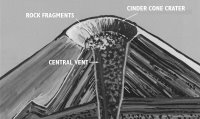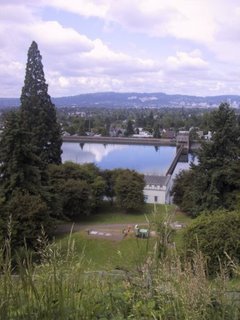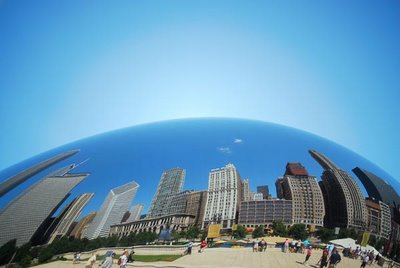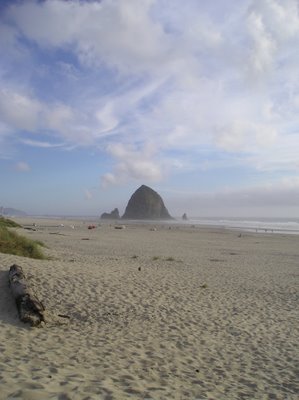The problem with descriptions of cathedrals is that writers assume readers understand not only the terminology designating the areas within the building but also the organizational role of the cathedral within the religious group. Descriptions loaded with special terms and insider jargon leave most of us with no better understanding than we had before we read them. Using myself as an example, I’ve attended Christian churches all my life -- even spent a good 20 years as an Episcopalian. I mention that because Episcopals have cathedrals, whereas Mennonites don’t. I have also visited and toured a fair number of cathedrals in various parts of the world. However, when reading about the Chichester Cathedral I found myself woefully unclear regarding many references and their implications. For this blog post, I made myself look up and clarify all my fuzzy understandings, and I’ve included definitions and explanations for all the terms I found necessary and meaningful to use here. I hope this helps you as much as it has helped me!
To appreciate the early history of the
Chichester Cathedral, you need to understand that a cathedral is more than just a great big church. A cathedral is the
bishop’s church and, as my son would once have said, the bishop is the
boss of all the churches of the region (i.e.,
diocese) and their respective priests. Note the hierarchy: priests run churches; bishops run cathedrals. The town in which the cathedral is located is called the
see, meaning the official seat or center of authority of a bishop. Considering all that, it's easy to see why the cathedral is usually the biggest and grandest church of the diocese.
This page on the organization of the Chichester Diocese explains very clearly the main “players” and their roles.
I read that the Chichester Cathedral’s history actually began in the village of Selsey, ten miles south of Chichester, on land given to Saint Wilfred in 681 AD. In 1066 AD the whole area was conquered by the Normans led by William the Conqueror. In 1075 the Normans moved the see to Chichester and began construction on a new cathedral in 1076. Histories of the Chichester Cathedral include references to its predecessor in Selsey because even though the Chichester building itself wasn’t begun until 1076, the functions served by that building remained the same as the functions of the Selsey building dating back to 681. In fact, there have been 101 bishops to rule over this particular diocese which extends throughout what is now defined as East and West Sussex, and only 76 of them have presided from the Chichester Cathedral. The point I’m making here is that this is obviously a very old building, but its history is even older.
Let’s turn our attention now to the building itself and the terms used to describe it. These terms are not words found in most people’s everyday vocabulary. Often a picture is the best explanation, so I scanned the floor plan found in a pamphlet I bought in the Cathedral bookstore,
Chichester Cathedral Pitkin Guide. North is at the top, but the front of a cathedral generally faces East. Knowing that, the descriptions will be easier to follow.

The initial period of construction from 1076 through 1123 was responsible for the
nave (central portion where people congregate), the
transepts (the portion of the building that forms a cross with the nave and provides additional seats which face the center), and the
quire (the center section where the choir sits and where the organ is located). The
presbytery (area to the east of the quire) contains the altar.
Actually, various parts of the cathedral were completed at different times over the years. The floor plan outlines the original early 12th century section in purple, later 12th and 13th century additions in red and green, and 14th through 16th century additions in pink and orange. My picture of St. Richard’s Walk below, taken from the south side of the Cathedral, captures construction from several of these periods. You can see the 13th century walls which lead to the 12th century building whose spire was rebuilt in the 19th century.

The marvelous arched ceiling inside the Cathedral was truly beautiful. I took this picture standing at the front of the nave looking back toward the main entrance.

Turning around, I faced the quire and the presbytery behind it. You can see the stalls in the quire as well as the altar decorations in the presbytery. In small weekday services both the choir and the congregants sit in the stalls in the quire.

Above the quire stalls are the painted Renatus Harris organ pipes dating back to 1678, reports the
Pitkin Guide. They were restored in 1986 after a silence of 13 years. I can tell you with certainty that their sound is as beautiful as their housing. Maurene and I sat beneath them in the quire stalls at the Choral Evensong service on the day of our visit.

And here’s a close-up of the white marble altar by Robert Potter and the tapestry by
John Piper (1966) which hangs on the screen behind the altar in the presbytery.
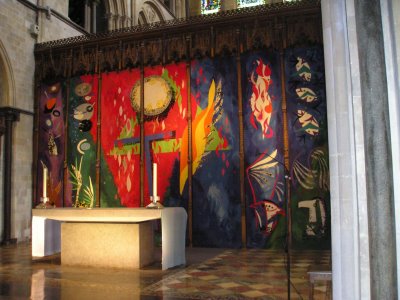
There’s not much ancient stained glass left in the Chichester Cathedral. Most of it comes from the 19th century. This window, located in the south transept, was designed by C. Parrish and made in 1877.

In the south quire aisle are two medieval sculptured stone panels dating back to 1125 AD. (This photograph was borrowed from the Chichester Cathedral website.)

Not far away a section of Roman tiled floor panels from the 2nd century can be seen beneath a plexiglass plate in the floor. These tiles were from the Roman city of
Noviomagus, the predecessor of Chichester.

Going around in back of the presbytery and into the
retroquire (area behind the presbytery, separated from it by the screen bearing the Piper tapestry above), we entered the Chapel of St. Mary Magdalene with its very modern décor. The striking 1960 painting below by
Graham Sutherland entitled “Touch me not” dominates the area.

After looking around this chapel, Maurene and I lit a candle and took a seat to gaze at the painting for a while. An announcement, repeated periodically, reminded us that although the Cathedral housed many significant works of art, its purpose was primarily that of worship. Visitors were encouraged to pause in their explorations of the cathedral and meditate. A timely and appropriate message, since that’s exactly what we were doing!
Also in the Chapel of St. Mary Magdalene is the small but stunning stained glass window designed in 1978 by
Marc Chagall.

The 12th century chapel on the east side of the north transept contain the Treasury, a small museum of interesting artifacts. I read in the
Pitkin Guide that “the Worshipful Company of Goldsmiths gave generous financial assistance to enable the cathedral to house and display securely its own treasures as well as plates from churches in the diocese.” Maurene and I enjoyed examining the medieval chalices and plates, bishops’ rings and the heads from bishops’ staffs, as well as some impressive medieval wooden chests.
Chichester Cathedral has a strong musical heritage. Leonard Bernstein composed the
Chichester Psalms in 1965 for the Cathedral.
Gustav Holst also had connections to the Cathedral and is buried there. His ashes are entombed under the diamond-shaped plate in the floor in the picture below. Since I played quite a lot of Holst's music in high school, I can't believe I somehow forgot to take a picture of his tomb! But here's the one I found on the website I linked to his name.

Completing our tour of the Cathedral itself, Maurene and I purchased some gifts and souvenirs in the Cathedral Gift Shop before adjourning to the Cathedral Snack Bar for a "cream tea.” Maurene explained to me that a cream tea consists of scones served with (specifically) strawberry jam and clotted cream. The scones were not the dry, hard things I’ve had in NYC. They were fresh and moist. The strawberry jam was densely strawberry in flavor. Despite its name, the clotted cream was not disgusting and did not have hard lumps in it like cottage cheese. It was a heavily whipped cream which was not as sweet as we make it in the US – a perfect compliment to the jam. The whole concoction can only be described as “to die for.” I most definitely thought I had gone straight to heaven with the first bite!
After tea we wandered through some of the town's tourist shops. I was sorry to discover that there was nothing as tacky as a shot glass to be found in the classy little village of Chichester. My shot glass collection would just have to make room for a small china thimble bearing a handpainted depiction of the Cathedral. That was as close as I could come.
At around 6:30 pm John, Betty’s driver, took us out to Betty’s house in Itchenor, a village on the Chichester Harbor about 20 minutes drive from the walled city of Chichester. After a walk around Betty’s extensive garden which includes an orchard and a grape arbor as well as flower beds and large fruit and vegetable patches, we enjoyed an informal cold supper with Betty and Sindy, her mischievious shelter rescue dog. Betty theorizes that Sindy’s clever food heists are signs of an earlier life deprived of adequate food. Whatever the reason, Sindy demonstrated her stealth and daring by stealing Betty’s prawns and some crisps (potato chips) when she thought nobody was looking! And here is our Sindy, enjoying a lie-down with a stomach full of prawns. I dare say Maurene and I probably looked just as content when we climbed into our beds that night after good company, good food, and after a jam-packed day (no pun intended) of touring in Chichester.

(P.S. All the pictures in this post are mine, except where otherwise noted.)
